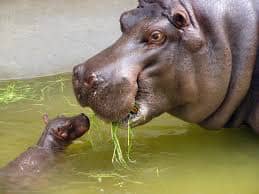What do Hippos Eat?

Hippopotamus are herbivorous animals and like to eat mainly short
grass. They also eat fruits. A recent report surprised the scientists that the hippos
eat meat, and now they are working together to uncover the hippo’s
exceptional behaviour.
Hippopotamus or hippo,
is the third largest land
animal after elephant and some rhinoceroses. The Latin word “Hippopotamus” comes from the
ancient Greek, meaning “horse of the river”. They belong to Hippopotamidae
family.
The average weight of a male hippo
is 1600kg to 4000kg and female is about 1400kg. They can grow up to 14 feet
long and up to 5.2 feet tall at the shoulder.
They have webbed feet but yet they are not actually good swimmer and not
can it float.
Hippo has powerful jaws. They can open their mouth almost 180° because the jaw hinge is located far back enough. The male hippo’s lower canine teeth and lower incisor teeth are enlarge and grow continuously and the canine teeth reach up to 40 cm. These teeth are used for combat but not used in feeding.
Hippo facts/Amazing Facts of Hippo
Hippos have broad horny lips which help
them to grasp and pull the grasses and their molar teeth help to grind the
grasses. Their three-chambered stomach helps them to digest the food but hippos
do not chew-cud.
Hippos spend the day time in the lakes and
rivers and can be found in Savannah and forest areas. At dusk, they leave the
water and travel inland up to 15km and spend 4 to 5 hours grazing 68kg of short
grasses each night. Short grasses are their main sources of food but they also
eat fruits.
In the day
time, hippos eat the short grass on the bank of the nearby water bodies
where they live, but they do not stay out of water for a long time because their
skin may crack or can lead to dehydration.
Do Hippos
Eat Meat?
Generally, we
know that the hippos are herbivores and like to eat short grass and some
kinds of wild fruits. But recently one PhD student Leejiah Dorward of Imperial
College, London experienced an unbelievable and rare experience, which makes
the scientists think anew about the hippo diet.
Leejiah
Dorward saw that one hippo was eating a quite decayed, dead hippo
in the river water when he was crossing the river in South Africa. He was
surprised to see the vegetarian hippo eating the carcass of his own
species.
This kind of
exceptional behaviour of hippo was also recorded by Dr. Joseph P Dubley
of the University of Alaska, US in 1995. He witnessed that the hippo
eats meat. He saw that the hippos at Hwange National Park, Zimbabwe,
were eating meat. Since
then, he's been gathering evidence that hippos eat impala, baby
elephants, and even their own species. There have been incidents of cannibalism in the animal range
from South Africa to Uganda.
According to hippo expert Dr Keith Eltringham,
hippos are not predators, but when they do not get enough food, they are
motivated to eat meat. Now Hippos face threat because of poaching and
habitat loses. Each year hundreds hippos being shot to keep them out of
crops. Hippos are killed by poachers for meat, fat and ivory canine
teeth.
Do Hippos
Eat Humans?
No, Hippo
does not eat humans. Hippo is considered to be extremely aggressive,
dangerous and unpredictable animal. They can charge and attack humans and
boats. They can easily attack or drown small boats and can injure the
passengers or kill them. In 2014, in Niger, a hippo attacked a small
boat filled with Nigerian school children. 12 children and one teacher were
killed by that hippo. In Africa, about 500 people are killed by
hippos in each year.
Ward off
enemies, hippo opens its big wide mouth and display their teeth which is
a warning against attack. Their jaws are so powerful that they can cut a canoe
in half with their jaws. When the hippos feel threatened they shake
their head, roar and grunt and make loud wheezing sound.
How do
Hippos Feed Their Babies?

Every two
years female hippo gives birth only one calf under water. The weight of
the new-born calf is between 25kg and 50kg and average length is 127cm. Then
the mother brings the calf up to the surface within 40 seconds for its first
breath. The calf rest on its mother’s back when the depth of the water is high
for the calf and suckle into the water as well as land. After three weeks of
its birth, the baby hippo or calf starts to eat grass but still rely on
mother milk for six to eight months. When the calf is about 5 to 7 years old, it becomes fully
mature.
Hippo Milk
Hippo produced white milk or off-white milk for their calves. Hippo’s body has less hair and the thickness of skin is 6cm which protects them from predator. A red-colored substance secretes from their skin and often called as “blood-sweat” but it is neither blood nor sweat. This substance is actually colourless but within minutes, it turns red-orange color and slowly becomes brown. In the secretion two pigments have been identified, red and orange. Both Red pigment (hipposudoric acid) and orange (norhipposudoric acid), are superior acidic compounds. These pigments protect the hippo from pathogenic bacteria and act as sunscreen and antibiotic. These pigments also regulate the body temperature of hippos.
Hippo’s milk is bright pink in colour
because of these two acids-hipposudoric acid and norhipposudoric acid. When two
acids combine with white milk and thus pink milk comes out. When the calf being
hungry, it tightly wraps its tongue around one of the two teats situated
between the mother’s hind legs and suckles. When it suckles the milk under
water, it closes its eyes and nostrils and forms a tight grip on the mother's
nipple between its tongue and the roof of the mouth. A cup of hippo milk
contains about 500 calories.
Conclusion
According to
International Union for Conservation of Nature (IUCN), hippos are
vulnerable to extinction. Now 125000 to 148000 hippos are surviving in
the wild. But poaching and habitat loss reduce their numbers.


.jpg)














0 Comentarios:
Post a Comment
Please do not use any abusing words or enter any spam links in the comment box